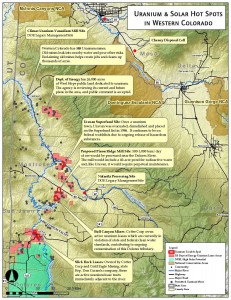 Uranium Mining and Milling
Uranium Mining and Milling
Haga clic aquí para leer la información en español.
Recently, the Department of Energy (DOE) announced considerations to kick-start uranium mining on thousands of acres across Western Colorado. Their Programmatic Environmental Impact Statement (PEIS) recommends continued uranium exploration and mine development in Mesa, Montrose and San Miguel Counties. The 31 leases cover 25,000 acres of public land, including tracts that surround the Dolores and San Miguel Rivers. Under the DOE’s preferred alternative, 19 new uranium mines in addition to the existing leases could operate simultaneously during the peak of operations.
Renewed uranium mining could bring jobs to Western Colorado, however also could bring a host of public health and environmental impacts. Our region has already carried the disproportionate burdens of an industry that has left behind a legacy of toxic waste and radioactive contamination that is still being remediated by taxpayer monies. We believe that a different future is possible for Western Colorado by putting people back to work cleaning up old mine sites and developing our potential as a renewable energy producer.
For more thoughts about the impacts of uranium mining, please click here.

BACKGROUND: In 1948 The BLM “withdrew” uranium mining claims within the Uravan Mineral Belt in SW Colorado to “reserve the uranium resources for the US Government.” The leases were transferred to the control of the Uranium Leasing Program (ULP) of the Dpt of Energy and were developed for the use of nuclear bombs during World War 1 and the ensuing Cold War era. In 1962 the leases expired and the sites were officially closed. Reclamation was not done at the time. In 1994, the DOE initiated a reclamation projects on all the lease sites. At that time lease sites were prioritized by the DOE and the “Legacy” claims were reconsidered for future development. In 2007 the DOE issued a “Finding of No Significant Impact” (FONSI) for the extension of 13 leases and the expansion of the ULP to include 25 additional lease tracts for the uranium industry. Exploration and other surface disturbance activities were conducted on the several of the lease sites between 2007 and 2011.
In July 2008 conservation partners challenged the FONSI. In Oct 2011 the court rules that the DOE had violated NEPA and invalidated the program, stopping the DOE for issuing any additional leases or approving additional activity on the lease tracts already leased. The court order forced the DOE to go back and conduct a thorough Program Environmental Impact Statement (PEIS) to determine all impacts from the lease program.
For more information contact organizer Emily Hornback (970) 256-7650
Piñon Ridge Uranium Mill
Western Colorado could see the first new American uranium mill in 30 years, the proposed Pinon Ridge Uranium Mill. If constructed, the Paradox Valley of Montrose County would produce an average of 500 tons per day of concentrated ore (a.k.a. yellow cake). Jobs are needed, but maybe uranium isn’t a sure thing economical or environmentally. Western Colorado still suffers the economic, environmental and health impacts from radioactive waste left after the last uranium bust 35 years ago.
The initial licence permit was applied for in 2009 and has been contested ever since. Today, uranium prices are dropping (again), and in response Energy Fuels, Inc. has sold off their Western Slope uranium assets to a private investor group led by Baobab Asset Management LLC and Montrose local, George Glasier, ex president of Energy Fuels. Last year, the same mill licence was again challenged in court when Denver District Judge Robert McGahey ruled that the contested license for the Piñon Ridge Uranium Mill needed further review to ascertain if the application from Energy Fuels truly meets “all criteria under state law.”
The order, which temporarily suspends the mill license, sent the license back to the Colorado Department of Public Health and Environment (CDPHE) to determine its legality. Currently, the license is back in CDPHE hands, and the laundry list of concerns and defects in the mill license application go unanswered. WCC members wonder if they ever will be addressed, or if the project is even relevant today, six years later.
So, will the mill be built or is it a done deal? Yet to be determined. Glasier has said he will not proceed until the price for uranium rises. A number of other permits must be obtained and they must meet the conditions of Montrose County and other permits. However the licence has not been fully denied or repealed. WCC continues to monitor the process and stands ready to engage.
Other Resources
- WCC’s talking points on the Piñon Ridge uranium mill proposal.
- Colorado Dept of Public Health & the Environment [CDPHE] website for Energy Fuels’ licensing process.
- Montrose County’s site on Energy Fuel’s Special Use Permit.
- Uranium Processing Accountability Act [Colorado House Bill 1348] fact sheet, passed in 2010.
- Uranium mining, tourism and outdoor recreation in Gateway, Colorado, A report from the Sonoran Institute.
